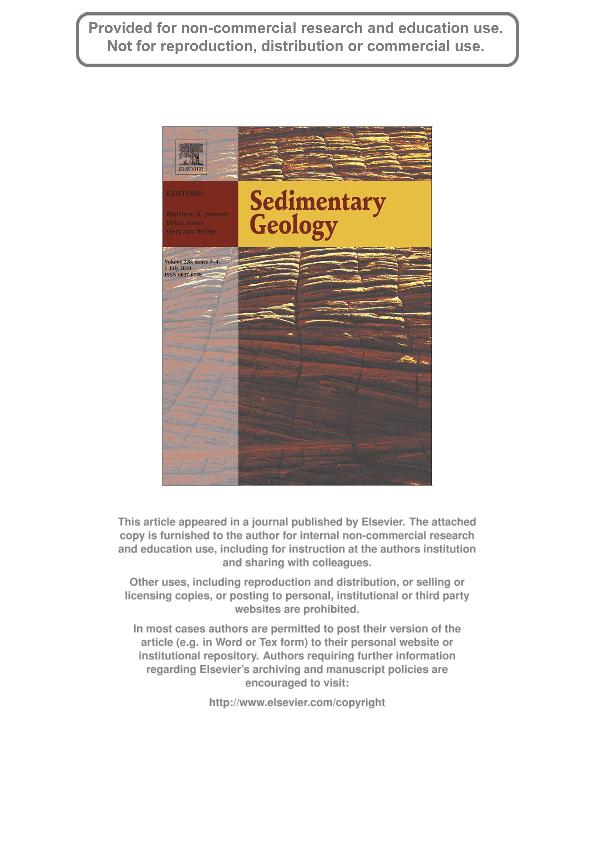Mostrar el registro sencillo del ítem
dc.contributor.author
Do Campo, Margarita Diana

dc.contributor.author
del Papa, Cecilia Eugenia

dc.contributor.author
Nieto, Fernando
dc.contributor.author
Hongn, Fernando Daniel

dc.contributor.author
Petrinovic, Ivan Alejandro

dc.date.available
2023-02-01T17:49:32Z
dc.date.issued
2010-04
dc.identifier.citation
Do Campo, Margarita Diana; del Papa, Cecilia Eugenia; Nieto, Fernando; Hongn, Fernando Daniel; Petrinovic, Ivan Alejandro; Integrated analysis for constraining palaeoclimatic and volcanic influences on clay-mineral assemblages in orogenic basins (Palaeogene Andean foreland, Northwestern Argentina); Elsevier Science; Sedimentary Geology; 228; 3-4; 4-2010; 98-112
dc.identifier.issn
0037-0738
dc.identifier.uri
http://hdl.handle.net/11336/186500
dc.description.abstract
Variations in clay-mineral assemblages in ancient continental deposits are frequently used to reconstruct past climate changes. In active settings, volcanic events can supply highly labile volcaniclastic material, which can easily be transformed into smectite via diagenesis, which can produce a noticeable footprint in clay-mineral assemblages. Southern Central Andean foreland deposits are appropriate case studies to ascertain whether the climatic signal was preserved in the clay assemblages of their fine-grained sediments as tectonic uplift, volcanism, and sedimentation have been interacting since the Cretaceous. We have studied a 1400-m-thick coarsening-upward Palaeogene succession of the Tin Tin basin (northern Calchaquí Valley, Argentina), applying X-ray diffraction (XRD), electron microscopy, and detailed sedimentary facies analysis with the aim of comparing tendencies in the vertical fluctuations of clay minerals with evidence from sedimentological facies.Illite-muscovite plus smectite account for 78% to 100% of the clay minerals in the fine fraction, with kaolinite and chlorite in subordinate amounts. The vertical variation of sedimentary settings from an overbank/lacustrine domain to fluvial braided plains and an aeolian dune field suggests a gradual increase in aridity upsection. However, smectite abundances do not show a gradual decreasing trend compatible with progressively lower hydrolyzing conditions; their relative abundances vary widely throughout the section, depicting pulse-like, abrupt fluctuations. Despite the absence of field evidence for volcanic influence, several indications of volcanic and volcaniclastic material have been found under scanning electron microscopy (SEM) in levels with high smectite abundances from the middle to the top of the succession. They include quartz crystals showing embayments and skeletal forms, with smectite filling the voids, microcrystalline silica, as well as heulandite crystals in close association with authigenic smectite. The XRD analyses of these levels evidence well-crystallized smectite, which is characteristic of a volcaniclastic origin. Therefore, the increase in smectite abundance in these beds reflects a significant volcaniclastic contribution, which is also evidenced by a centimetre-thick ash layer topward in the sequence. The only smectite-rich level near the base of the Tin Tin section also contains well-crystallized smectite associated with heulandite, thus probably evidencing volcaniclastic input. We infer that most of the smectite in these sediments formed during early diagenesis, probably through the dissolution of labile tuffaceous material. Textural and morphological analysis by SEM is essential to determine whether clay-mineral assemblages could be interpreted in terms of palaeoclimate.
dc.format
application/pdf
dc.language.iso
eng
dc.publisher
Elsevier Science

dc.rights
info:eu-repo/semantics/openAccess
dc.rights.uri
https://creativecommons.org/licenses/by-nc-sa/2.5/ar/
dc.subject
CLAY MINERALS
dc.subject
FORELAND BASINS
dc.subject
NORTHWEST ARGENTINA
dc.subject
SMECTITE
dc.subject
VOLCANICLASTIC MATERIAL
dc.subject.classification
Geología

dc.subject.classification
Ciencias de la Tierra y relacionadas con el Medio Ambiente

dc.subject.classification
CIENCIAS NATURALES Y EXACTAS

dc.title
Integrated analysis for constraining palaeoclimatic and volcanic influences on clay-mineral assemblages in orogenic basins (Palaeogene Andean foreland, Northwestern Argentina)
dc.type
info:eu-repo/semantics/article
dc.type
info:ar-repo/semantics/artículo
dc.type
info:eu-repo/semantics/publishedVersion
dc.date.updated
2023-01-31T12:29:30Z
dc.journal.volume
228
dc.journal.number
3-4
dc.journal.pagination
98-112
dc.journal.pais
Estados Unidos

dc.journal.ciudad
Amsterdan
dc.description.fil
Fil: Do Campo, Margarita Diana. Consejo Nacional de Investigaciones Científicas y Técnicas. Oficina de Coordinación Administrativa Ciudad Universitaria. Instituto de Geocronología y Geología Isotópica. Universidad de Buenos Aires. Facultad de Ciencias Exactas y Naturales. Instituto de Geocronología y Geología Isotópica; Argentina
dc.description.fil
Fil: del Papa, Cecilia Eugenia. Universidad Nacional de Salta; Argentina. Consejo Nacional de Investigaciones Científicas y Técnicas; Argentina
dc.description.fil
Fil: Nieto, Fernando. Universidad de Granada; España
dc.description.fil
Fil: Hongn, Fernando Daniel. Universidad Nacional de Salta; Argentina. Consejo Nacional de Investigaciones Científicas y Técnicas; Argentina
dc.description.fil
Fil: Petrinovic, Ivan Alejandro. Universidad Nacional de Salta; Argentina. Consejo Nacional de Investigaciones Científicas y Técnicas; Argentina
dc.journal.title
Sedimentary Geology

dc.relation.alternativeid
info:eu-repo/semantics/altIdentifier/doi/http://dx.doi.org/10.1016/j.sedgeo.2010.04.002
dc.relation.alternativeid
info:eu-repo/semantics/altIdentifier/url/https://www.sciencedirect.com/science/article/abs/pii/S0037073810000886
Archivos asociados
